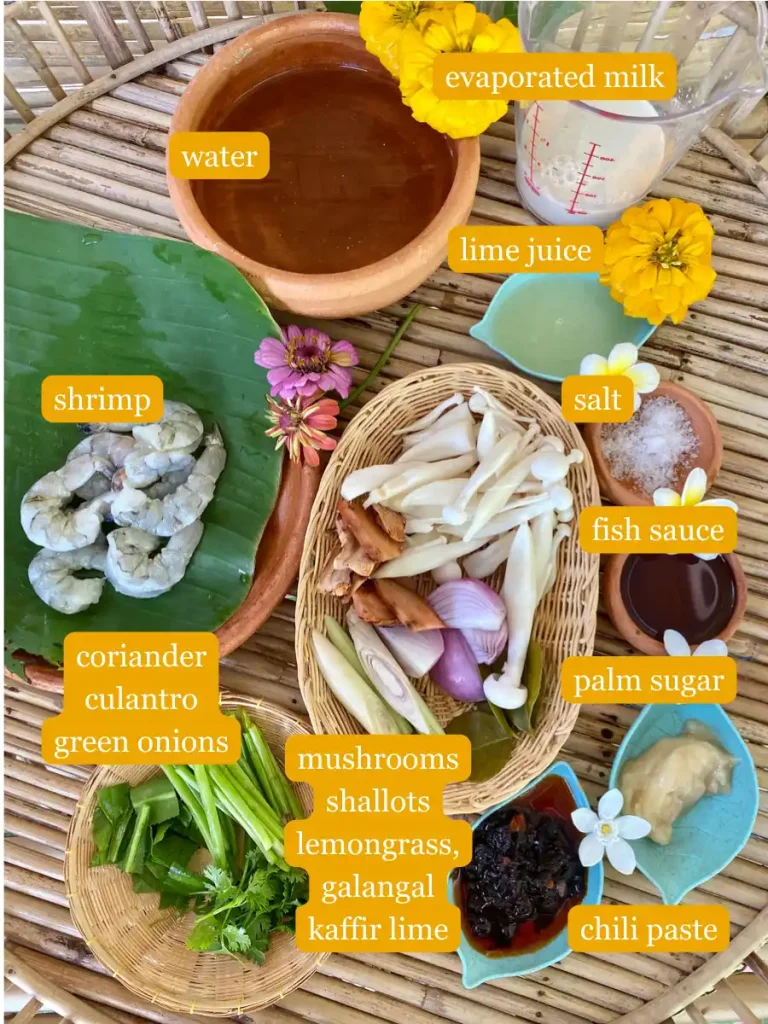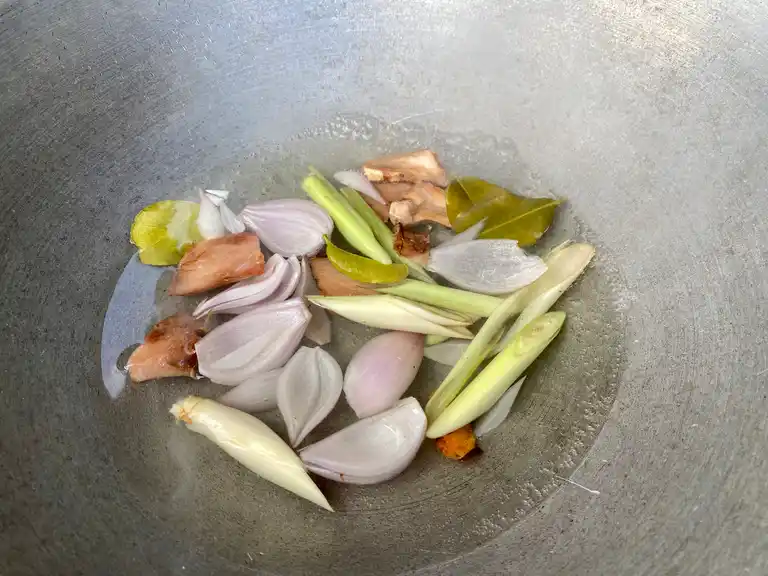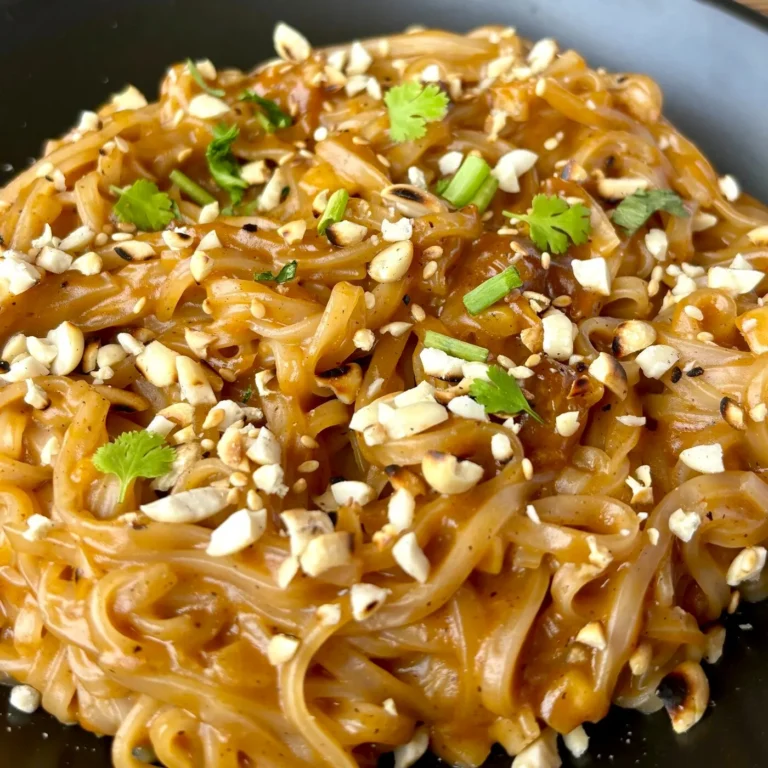Tom Yum Kung Recipe (Spicy Thai Shrimp Soup)
As an Amazon Associate, I earn from qualifying purchases. Read the full disclosure here .
This tom yum kung recipe is easy to make and perfect for a healthy lunch or a light evening meal. It’s a sour spicy Thai shrimp soup made with fresh ingredients such as homemade chili paste, lemongrass, and galangal. Perfect for busy weekdays!

The great thing about my Thai soup recipes is that you can swap the protein in many of them to create a completely new dish. For example, you can make tom yum talay (seafood soup), tom yum pla (fish soup), and tom yum noodle soup if you like noodles.
To add even more of that delicious tom yum flavor, you can simply add tom yum paste to taste to any of these soups. Be sure to also try my tom yum fried rice!
This recipe comes with a wealth of information. Feel free to skip it, or if you’d like to learn more about the soup, then be sure to read on!
What is tom yum kung
Tom yum kung is a healthy Thai hot and sour shrimp soup made with lemongrass, galangal, and kaffir lime leaves. It’s one of the world’s most famous Thai dishes, also known as tom yam kung.
In Thai language, tom yum or tom yam means boiling mix, and kung or goong means shrimp.
Tom yum soup history
The origin of tom yum kung is a bit of a mystery. It’s suspected that tom yum soup originated in central Thailand because there are a lot of freshwater shrimps there.
As with many authentic Thai recipes, Thai families have made their own versions and adjusted the flavors to what they find delicious. The modern versions that we find today may contain ingredients and spices that were not used in the original tom yum recipe. But the key characteristic flavors, hot and sour, haven’t changed a bit.
The flavor of tom yum varies from kitchen to kitchen, and even when you travel in Thailand, from the north to the south, you will encounter very different tastes.

The broth of tom yum kung can vary from a clear broth to a creamier broth when made with evaporated milk. I like both equally, and my hubby prefers the creamier soup with coconut milk. This easy recipe for tom yum goong is one that I love to make on days when I lack inspiration!
Tom yum vs tom kha
Those new to the world of Thai cuisine might wonder about the differences between tom yum and tom kha. They differ greatly in taste, ingredients used, and even the protein choice.
- Tom yum soup is known for its spicy and sour flavors, with salty and slightly sweet notes also present. It’s commonly prepared with shrimp but can also be made with seafood or chicken. Traditionally, it’s supposed to be a very spicy soup, featuring many red chili peppers.
- Tom kha soup, on the other hand, is creamier since it’s made with coconut milk. It’s a milder soup, with chicken often being the protein of choice. This Thai soup is a real comfort food, perfect for families and children.
If you’d like to try an authentic tom kha soup, be sure to try my recipe for tom kha gai, Thai coconut chicken soup.
Spicy Thai shrimp soup recipe
As mentioned before, tom yum kung (also spelled as tom yum goong and tom yum koong soup) is one of the most famous soups globally. This authentic recipe is perfect for every home cook and lets you discover the spicy and sour flavors you’d get in Thailand.
Can’t get enough of tom yum flavor? You’ll love my recipes for tom yum gai, dry tom yum noodles, and tom yum fried rice!
If you love Thai food, then this sour spicy shrimp soup is a must-try. Make sure to use fresh ingredients, such as fresh lemongrass, galangal, and kaffir lime leaves. These ingredients are very important in Thai cuisine, and using fresh ones contributes significantly to the final taste of your soup.

You can opt for shrimp, prawns, squid, or even chicken. I love to keep the heads and shells on the shrimp, as they also contribute to the flavor.
Before serving your soup, be sure to taste it first. It should have mostly hot and sour flavors, but also a subtle saltiness and sweetness.
Ingredients
Ingredients can be sourced at Asian grocery stores and Asian markets.
The exact measurements are in the recipe card at the end of this post.

- Water
- Shrimp – If you can find them, use black tiger shrimp or jumbo shrimp. You can also make this recipe for tom yum soup with other seafood or chicken.
- Lemongrass, galangal, kaffir lime leaves (makrut) – Opt for fresh herbs and spices. If you can’t find fresh, frozen works too. You can substitute galangal for ginger, but the flavors won’t be the same.
- Green onions, culantro, coriander – These herbs add a fresh flavor and aroma.
- Mushrooms – You can opt for oyster mushrooms, shimeji, shiitake, enoki, or straw mushrooms. Any Asian mushroom can be used in this Thai shrimp soup.
- Thai chili paste – You can opt for store-bought Thai chili paste, but if you want authentic flavors, use my Thai chili paste recipe.
- Evaporated milk – For a creamy Thai tom yum soup with shrimp, use canned evaporated milk, different from coconut milk or sweetened condensed milk.
- Fish sauce – Fish sauce adds a salty and umami flavor. It’s a staple in Thai and Southeast Asian cuisines. Look for a high-quality fish sauce brand like red boat fish sauce or megachef.
- Palm sugar – Palm sugar adds a subtle, caramel-like sweetness, distinct from white and brown sugar.
- Lime juice – Fresh lime juice is essential for the sour flavor.
- Shallots
- Salt
- Thai chili peppers (optional) – Spice up your soup with Thai chilies, like bird’s eye chilies or Thai Jinda chilies.
Learn more about Thai pantry staples.
Short recipe video
How to make tom yum kung

Step 1: Peel and devein the shrimp, set them aside for later use. You can also prepare this soup with head-on or shell-on shrimp for extra flavor.

Step 2: In a wok or pot over medium heat, bring water to a boil. Once boiling, introduce the shallots, lemongrass, galangal, and kaffir lime leaves to the water.

Step 3: After simmering for approx 3 minutes, add the chili paste, palm sugar, fish sauce, salt, fresh lime juice, and mushrooms. Stir well until the mixture returns to a boil. At this point, taste the soup and adjust seasoning if needed.

Step 4: Add the evaporated milk to the pot and allow the soup to simmer for a few additional minutes.

Step 5: Introduce the shrimp and cook them until they are nearly done. Don’t overcook them, they will continue to cook in the boiling soup.

Step 6: Finally, stir in the green onions, culantro, and coriander. Serve the soup immediately, garnishing each bowl with additional chilies, coriander, green onions, and culantro.
Kitchenware
Here’s what you’ll need for making this spicy Thai shrimp soup:
- Cutting board and a sharp knife
- Measuring spoons and cups
- Large pot or Dutch oven
- Strainer or skimmer (optional, for removing spices from the soup)
- Ladle (for serving and stirring)
Tom yum goong recipe tips
- Remove or leave in galangal, lemongrass, and kaffir lime leaves. These ingredients are essential for flavors but are not meant to be eaten. You can choose to remove them before serving or leave them in for nice presentation.
- Taste test and adjust seasonings for balance. Achieving the perfect balance of sour, spicy, salty, and sweet is key in Thai cooking. In Thai restaurants, soups are always tasted before being served.
- Use fresh and high-quality ingredients. The flavor of this tom yum recipe relies on the freshness of the ingredients. If possible, opt for fresh shrimp from a fish market, and choose fresh herbs and spices.
- Add shrimp towards the end of cooking. Shrimp cook quickly and can become tough if overcooked. Add them to the soup last and watch closely until they are just soft and pink.
- Feel free to add some vegetables. If you wish, you can add soup vegetables like like bell peppers, baby corns, snap peas, and tomatoes.
Tom yam kung serving suggestions
Serve your tom yum kung hot in individual bowls or at the center of the table for sharing. It’s perfect with steamed jasmine rice or by itself, enhance the meal with side dishes like shrimp satay with peanut sauce and shrimp larb. Garnish with Thai chili flakes, a lime wedge, and fresh herbs like cilantro or green onions.
Tom yum koong storing and reheating
Storing: Let the leftovers cool down to room temperature and store them in an airtight container in the refrigerator. They will last for up to 3 days.
Freezing: You can freeze this soup for later, but the structure of the shrimp may change. I advise enjoying it fresh.
Reheating: Reheat the leftovers in a pot on the stove over medium heat. Alternatively, you can use a microwave.
Good to know
- Spicy Thai food can make you feel better when you’re sick, and this spicy tom yum soup is perfect for that. It helps you sweat, cooling down your body and flushing out toxins.
- Tom yum is packed with health benefits. Ingredients like lemongrass, galangal, and kaffir lime leaves make it a natural Thai remedy. It aids digestion, reduces inflammation, and strengthens your immune system.
Frequently asked questions
What is in tom yum goong?
Tom yum goong has shrimp, lemongrass, galangal, kaffir lime leaves, mushrooms, Thai chili, fish sauce, lime juice, and sometimes chili paste. Modern versions may include evaporated milk or coconut milk for a creamy version.
Is tom yum goong soup spicy?
Yes, it’s spicy due to the Thai chilies and chili paste, but you can adjust the heat to your liking.
What does tom yum taste like?
Tom yum has a unique blend of spicy, sour, and a hint of salty and sweet flavors. The flavors are refreshing with a hint of lime and lots of spice.
Can I make tom yum soup vegetarian?
Absolutely! Just swap shrimp for tofu and use soy sauce or a vegan fish sauce instead of fish sauce to keep it vegetarian.
Is this recipe gluten-free?
Yes, the recipe is gluten-free as long as you ensure that your fish sauce and any added chili paste are gluten-free.
Authentic Thai soup recipes
- Tom yum mama
- Thai lemongrass soup recipe
- Thai vegetable soup
- Thai bamboo soup
- Boat noodles
- Khao tom (Thai rice soup)
Loved reading this authentic tom yum kung recipe? Please make my day by dropping a star rating and/or a comment below! Follow me on social media: Facebook, Instagram, and Pinterest.
Tom Yum Kung Recipe (Spicy Thai Shrimp Soup)

Ingredients
- 10 medium shrimp, see notes
- 100 g mushrooms, sliced
- 2 stalks lemongrass, roughly chopped
- 30 g shallots, sliced
- 3 kaffir lime leaves
- 6 thin slices galangal
- 30 g Thai chili paste, see notes
- 45 ml fish sauce
- 5 g salt
- 15 g palm sugar
- 30 ml lime juice
- 100 ml evaporated milk
- 350 ml water
- green onions, sliced, to taste
- culantro, chopped, to taste
- coriander, chopped, to taste
Instructions
- Peel and devein the shrimp, set them aside for later use. You can also cook this soup with head-on or shell-on shrimp for extra flavor.
- In a wok or pot over medium heat, bring water to a boil. Once boiling, introduce the shallots, lemongrass, galangal, and kaffir lime leaves to the water.2 stalks lemongrass, 30 g shallots, 3 kaffir lime leaves, 350 ml water, 6 thin slices galangal
- After simmering for approx 3 minutes, add the chili paste, palm sugar, fish sauce, salt, fresh lime juice, and mushrooms. Stir well until the mixture returns to a boil. At this point, taste the soup and adjust seasoning if needed.30 g Thai chili paste, 45 ml fish sauce, 5 g salt, 15 g palm sugar, 30 ml lime juice, 100 g mushrooms
- Add the evaporated milk to the pot and allow the soup to simmer for a few additional minutes.100 ml evaporated milk
- Introduce the shrimp and cook them until they are nearly done. Don’t overcook them, they will continue to cook in the boiling soup.10 medium shrimp
- Finally, stir in the green onions, culantro, and coriander. Serve the soup immediately, garnishing each bowl with additional chilies, coriander, green onions, and culantro.green onions, culantro, coriander
Notes
- Use the nutrition card in this recipe as a guideline
- Thai chili paste - You can opt for store-bought Thai chili paste, but if you want authentic flavors, use my Thai chili paste recipe.
- Shrimp - If you can find them, use black tiger shrimp or jumbo shrimp. You can also make this recipe for tom yum soup with other seafood or chicken.
- Garnish with fresh herbs and chilies to taste.
- Galangal, lemongrass, and kaffir lime leaves are not to be eaten, you can choose to take them out of the soup before serving or serve as it is.







This was phenomenal! I subbed coconut sugar for palm since that’s what I had, and used coconut milk since we’re dairy free. Best Thai soup I’ve made. Your chili paste recipe added so much flavor and I don’t think we’ll be able to go back to store bought! It was also convenient to leave the soup base mild and add to individual bowls so my kids could add less spice. Thank you.
Hey Steffani! I’m really happy you tried and enjoyed my recipe, thank you!
Genuine best recipe
Thank you so much!